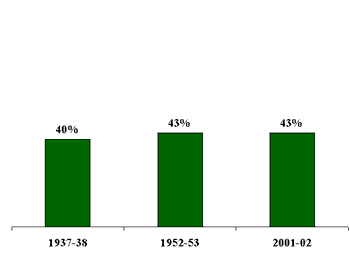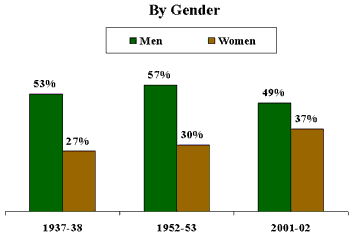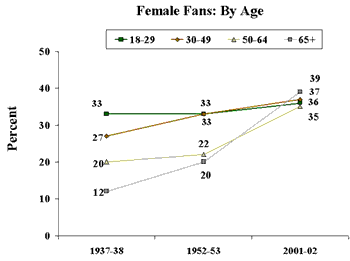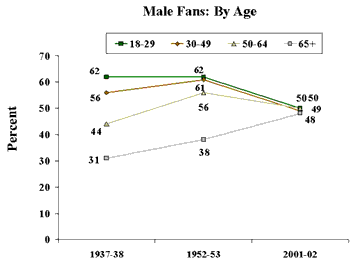GALLUP NEWS SERVICE
PRINCETON, NJ -- An analysis of Gallup data over the past six and a half decades suggests that the number of Americans who consider themselves fans or followers of baseball has remained remarkably steady. The questions that have been asked to measure allegiance to that sport have varied over the years, so an exact comparison is not possible. Still, the trend of responses provides intriguing insights into the changing nature of fans and suggests that the future of baseball may not be as bright as it is today.
The wording change is not trivial. In the 1930s, respondents were asked if they followed "big league baseball." In the 1950s, they were asked if they followed "major league baseball at all." And currently people are asked if they are "a fan of professional baseball, or not." In this last version, people can say yes or no, or they can indicate they are "somewhat" of a fan, an option that typically adds about 10% to 12% of Americans to the fan base. However, to make the results more comparable with those measured in the 1950s and 1930s, that extra group of "somewhat" fans is not included.
In the three surveys conducted in the 1937-1938 period, Gallup found an average of 40% of Americans who said they followed big league baseball. In the early 1950s (based on an aggregate of three surveys in 1951-1952), an average of 43% of Americans said they followed "major league baseball." And in three surveys in 2001 and a fourth in 2002, the average number of people who described themselves as "a fan of professional baseball" was also 43%.
| Fan or Follower of Professional/Major League Baseball? |
 |
Many Women Have Become Fans; Many Men Have Found Other Interests
One of the great boons to baseball has been the increased number of women who follow the sport. In the 1930s, just 27% of women said they followed baseball, but by 2001-02, that number increased to 37%. Men, by contrast, show an increase in fans from the 1930s to the 1950s, but then show a significant drop from the 1950s until now. Today, just 49% of men say they are fans, compared with the 57% of men who followed baseball in the 1950s, and the 53% who followed the sport in the 1930s.
| Fan or Follower of Professional/Major League Baseball? |
 |
The increase in female fans is found primarily among older women. Among the youngest group of women, under 30, the percentage of fans has remained fairly constant: 33% in the 1930s, 33% in the 1950s, and 36% currently. However, the percentage of fans among females in the other three age groups has increased substantially from the 1930s until now.
| Fan or Follower of Professional/Major League Baseball? |
 |
These results augur well for baseball, as younger women today are as enthusiastic about the sport as were younger women in previous years.
The decline in male fans is found in the youngest two age groups, at the same time that there has been an increase in fans among the older two groups. In the 1930s, 62% of young men (under 30) said they followed big league baseball, the same percentage who said they followed major league baseball in the 1950s. But today, that percentage has dropped to 50%. Similarly, among the 30-49 age group, there has been a drop from the 1950s (61%) until now (49%), despite the initial rise in fans from the 1930s (56%).
| Fan or Follower of Professional/Major League Baseball? |
 |
Note also the increase in number of fans among the oldest group, from 31% in the 1930s to 48% today. The 50-64 age group also shows a net increase: 50% today, compared with 44% in the 1930s. However, this group shows a decline of six percentage points from the 1950s, when 56% followed major league baseball.
The Future May See Fewer Male Fans
These results suggest that baseball has become less popular than it used to be among younger men. In the future, as these young and middle-age men grow older, their relative lack of interest may cause a decline in the overall number of baseball fans. One reason for the sport's greater popularity among older men may be that these men have always found the sport popular but are now in the older age category. As these men pass from the scene, the sport's base is likely to decline.
Among women, by contrast, the base of support for baseball seems about equally strong among the four age groups. Over a third of women in each age category say they are fans today, a demographic that portends well for the stability of female fans in baseball's future.
Survey Methods
The results reported here are based on 10 Gallup surveys of adults nationwide-- three conducted in person in 1937-1938, three in person in 1952-1953, and four by telephone in 2001-02. The sample size for the 1930s surveys is 8,946; for the 1950s surveys, 3,569; and the 2001-02 surveys, 4,058. For results based on the total sample of adults in each of the three groups of surveys, one can say with 95% confidence that the margin of sampling error is no greater than ±2 percentage points. In addition to sampling error, question wording and practical difficulties in conducting surveys can introduce error or bias into the findings of public opinion polls.